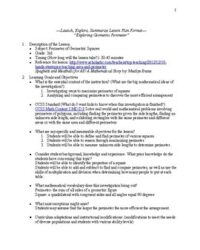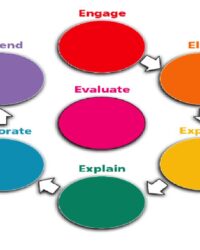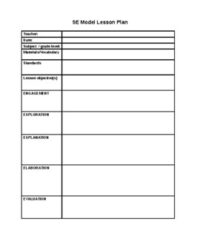Ever found yourself staring at a blank document, tasked with creating a lesson plan that truly sparks curiosity and deep understanding in your students? You’re not alone. Many educators seek a framework that moves beyond traditional lecturing, aiming for a more engaging and effective learning experience. That’s where the 5 E Model comes in – a fantastic, constructivist approach to teaching that guides students through a journey of discovery and knowledge building.
This model isn’t just about covering content; it’s about fostering critical thinking, problem-solving, and a genuine connection to the subject matter. It provides a structured yet flexible pathway for students to construct their own understanding of concepts. If you’re ready to transform your lessons and empower your students, understanding and utilizing a well-crafted 5 E model lesson plan template is your next step.
Understanding the 5 E Model: A Deeper Dive
The 5 E Model is an instructional sequence developed by the Biological Sciences Curriculum Study (BSCS) that provides a comprehensive framework for designing and delivering lessons. It’s rooted in constructivism, meaning it emphasizes that learners build their own understanding and knowledge of the world through experiencing things and reflecting on those experiences. Instead of just being told information, students actively engage with concepts, explore ideas, explain their findings, elaborate on their understanding, and evaluate their learning. Let’s break down each crucial phase.
Engage
The Engage phase is all about capturing your students’ attention and activating their prior knowledge. This is where you introduce a topic, pose a question, or present an intriguing scenario that hooks them into the lesson. The goal isn’t to teach new content yet, but to pique their curiosity, connect to what they already know (or think they know), and get them excited about what’s to come. Think about starting with a surprising fact, a short video, a real-world problem, or a thought-provoking demonstration.
Explore
Once engaged, students move into the Explore phase. This is the heart of discovery learning, where students actively investigate the concept. They might conduct experiments, observe phenomena, collect data, or work collaboratively to solve a problem. As the teacher, your role shifts from lecturer to facilitator, guiding students with questions, providing resources, and observing their interactions. This hands-on experience allows them to grapple with ideas, make observations, and begin to form their own conclusions before formal definitions are introduced.
Explain
The Explain phase is where students articulate their understanding based on their explorations, and you, the teacher, introduce formal concepts, definitions, and theories. Students share what they’ve observed and learned during the Explore phase, using their own words. This is your opportunity to clarify misconceptions, introduce vocabulary, and present content directly, linking it back to their experiences. It’s a collaborative process where students’ prior discoveries inform and give context to the new information being presented.
Elaborate
In the Elaborate phase, students extend their conceptual understanding and apply what they’ve learned to new situations. This helps them deepen their knowledge and see the relevance of the concepts in different contexts. Activities might include solving more complex problems, designing their own experiments, conducting further research, or applying the concepts to real-world scenarios. This phase encourages higher-order thinking and reinforces the learning, ensuring students can transfer their knowledge effectively.
Evaluate
Finally, the Evaluate phase allows both students and teachers to assess understanding. This can happen throughout the lesson informally, but the Evaluate phase specifically focuses on determining how well students have grasped the concepts and skills introduced. Assessment can take many forms, from traditional quizzes and tests to performance-based tasks, presentations, or self-reflection activities. It’s not just about grades; it’s about providing feedback and identifying areas where further instruction or practice might be needed.
Why a 5 E Model Lesson Plan Template is Your Best Friend
Creating effective lessons within the 5 E framework can seem daunting at first, especially when you’re trying to remember all the nuances of each phase. This is precisely where a well-designed 5 e model lesson plan template becomes an invaluable tool. It acts as a structured guide, ensuring that you don’t miss any critical steps and that your lessons consistently foster deep student understanding rather than just surface-level recall. It’s like having a co-pilot for your lesson planning journey, keeping you on track and focused on student engagement.
Beyond providing structure, a template significantly streamlines your planning process. Instead of starting from scratch every time, you have a ready-made outline that prompts you to consider all the necessary elements: what activity will engage them, what materials are needed for exploration, how will you facilitate explanation, what opportunities exist for elaboration, and how will you assess understanding? This consistency not only saves time but also leads to more cohesive and effective instruction across all your units.
Ultimately, using a consistent 5 E model lesson plan template frees up your mental energy to focus on the truly creative and responsive aspects of teaching – tailoring activities to your specific students’ needs, anticipating misconceptions, and providing targeted feedback. It helps ensure that every lesson you deliver moves beyond simply covering content to truly building knowledge and skills in a meaningful way for your students. It’s about working smarter, not just harder, to achieve remarkable learning outcomes.
- Provides a clear, consistent structure for every lesson.
- Ensures all five critical phases of the learning cycle are addressed.
- Saves significant planning time and reduces cognitive load.
- Helps align activities with specific learning objectives.
- Facilitates reflective practice and lesson refinement over time.
- Supports differentiation by prompting consideration of diverse student needs at each stage.
Embracing the 5 E Model, especially with the aid of a structured template, transforms your approach to teaching from a content delivery system to a dynamic learning experience. It empowers you to design lessons that are not only comprehensive but also deeply engaging, encouraging students to become active participants in their own education. This shift fosters a classroom environment where curiosity thrives, and genuine understanding takes root, preparing students not just for tests, but for lifelong learning.
By consistently applying this framework, you’ll observe your students developing stronger critical thinking skills, a greater capacity for problem-solving, and a more profound connection to the subject matter. It’s a testament to the power of guiding students through an inquiry-based process, rather than simply spoon-feeding them information. The result is a more vibrant classroom, where both teaching and learning become a truly rewarding journey.


